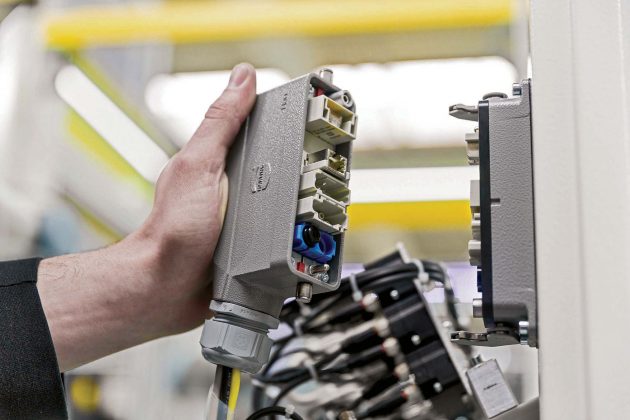
Five trends in industrial communication technology
By Ralf Klein
Industry Electronics Manufacturing communication industrial manufacturing networksConnectors are smaller, smarter and can be customized.

Han-Modular rectangular connectors combine power, signal, data and/or compressed air feeds. PHOTO: HARTING
The COVID-19 pandemic has thrown a wrench into normal activity for industrial automation manufacturers – no in-person trade shows, no going to technical conferences, making sales calls or giving live demonstrations.
Yet innovation hasn’t stalled. Engineers are working from home, sharing work on new products and concepts. If anything, interaction with customers has intensified.
There’s no delay in product development. In some ways, it’s moving even faster thanks to this acceleration of digital communications.
Network and industrial connectivity innovations making it to market are being driven by these ongoing trends:
1. Miniaturization – less is better. Device manufacturers are continually looking to shrink their products, so connector manufacturers must always miniaturize theirs. That cuts across all market segments. Space-saving connectors support multiple small drives and displays with the same reliability and flexibility expected from larger connectors.
2. Connectorization – why connectors are prevailing. With the prevalence of modular machine design, connectors are increasingly preferred to hardwiring/lugging for wiring such systems. They’re plug and play. Hardwiring is time-consuming. Many OEMs have found the true cost of hardwiring is greater, not less, than connectorized wiring once they account for the labour associated with breaking down the machine into sections for shipping and reassembling it at the customer’s location. Connectors speed troubleshooting and shorten downtime. Additionally, connectors are perfect for applications where wiring is detached, such as frequent tool changes or for rapid machine changeovers in IIoT for custom and small-batch production.
3. Customization – having it your way. The great strength of rectangular industrial connectors has always been modularity. Users configure them for the precise needs of applications using standard components. There is a big push to expand digital services online and downloadable that makes the user’s configuration experience that much easier and faster.
4. Smart Connectivity – the smart idea. Modular industrial connectors evolved to performing active functions, such as surge voltage protection, to protect digital or analogue I/O sensor circuits, or provide energy measurement and status monitoring. Putting surge protection, energy measurement, machinery ID and an ethernet switch in the connector eliminates the need for separate devices and cabling for these functions. For example, putting surge protection in the connector dispenses with the need for multiple surge arresters inside a control cabinet.
5. Last but not least – the (near) future of IIoT. What’s in the future? There are several promising areas, such as solutions for DC power transmission and e-Mobility, but single pair ethernet (SPE) is quickly coming into focus. The Industry 4.0/IIoT environment relies on data. Employing SPE in the lower levels of the automation pyramid promises to be the simplest, fastest and cheapest way to integrate hundreds and even thousands of sensors and other devices requiring only low power and limited bandwidth into a TCP/IP network from shop floor to the cloud. SPE delivers data and power simultaneously over a single pair of twisted copper wires. The cabling is thinner, lighter and less expensive than other ethernet or bus cabling. And most connected devices won’t need a battery or separate power cable.
SPE is fully standardized, and generic which promises to sustain a robust, competitive marketplace. There will be a large array of connectors with protection ratings up to IP65/67, in familiar styles including M8 and M12 and proven locking mechanisms like latch, screw and push-pull.
Development of new physical-layer (PHY) chips, cables, and test solutions is proceeding, with SPE-compatible devices likely to begin arriving in earnest in 2021. It’s something to watch.
Ralf Klein is managing director of Harting Electronics in Espelkamp, Germany. Harting’s Canadian headquarters is in Saint-Laurent, Que. Visit www.harting.ca.
This article first appeared in the July-August 2020 print edition.
